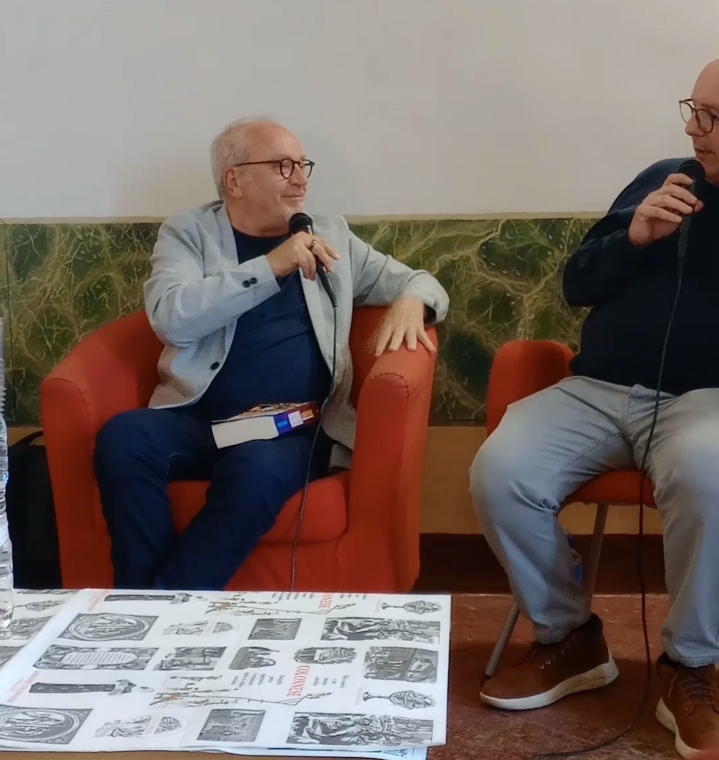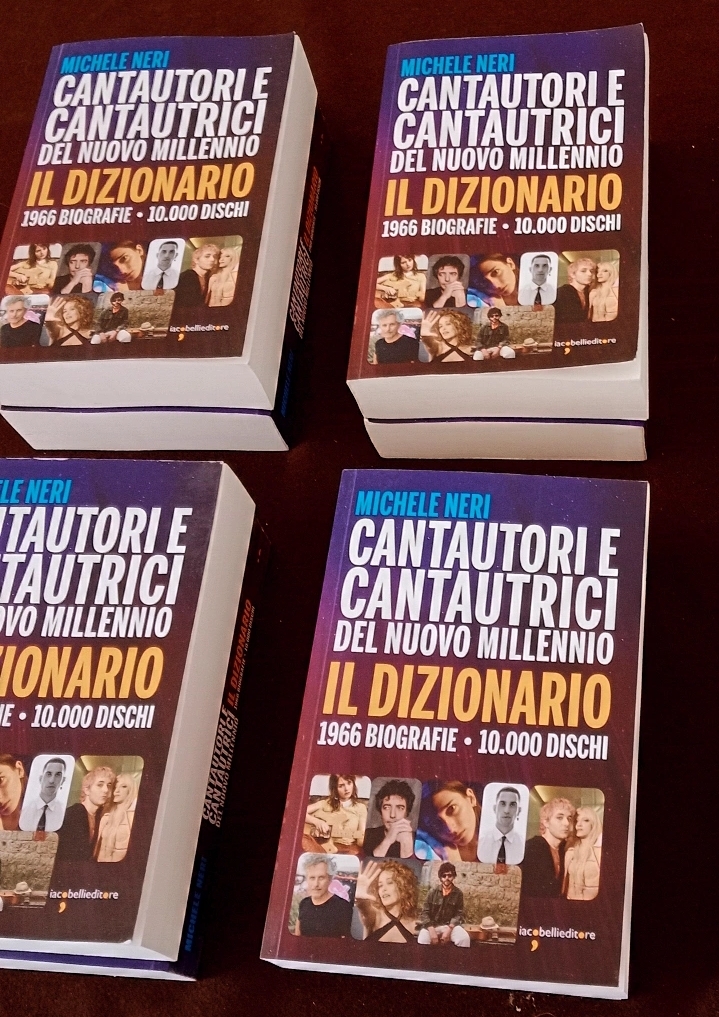Nella bellissima cornice di Palazzo Reale alla Fondazione Mezzogiorno Europa si è svolta la presentazione del libro di Michele Neri “Cantautori e Cantautrici del nuovo millennio. Il Dizionario”. 1966 biografie, 10.000 dischi. Un libro che invita a riscoprire la bellezza del cantautorato italiano, un volume imponente, monumentale che non fa alcuna distinzione di genere; artisti conosciutissimi con album e canzoni di successo, mentre altri molto meno. Il tutto in 537 pagine, che partono dalla A di “Aba” e arrivano alla zeta di “Tonino Zurlo”. Nel mezzo, il resto: Vinicio Capossela, Carmen Consoli, ma anche Simona Boo, Roberto Colella, Myriam Lattanzio, Inkenzamente (Chiara Amici).
Un libro curato da Michele Neri, autore e consulente RAI, storico della musica italiana, saggista. Un’opera definita dal coordinatore dell’incontro, Gino Aveta, come la Bibbia del cantautorato moderno.

Il criterio è stato quello di occuparsi di tutti i cantautori e tutte le cantautrici che hanno iniziato la loro carriera artistica entro la prima metà degli anni Novanta del secolo scorso.
«Il valore di un’opera come questa – indipendentemente dalla sua perfezione o dal fallimento che possa aver incontrato in determinate cose, ci dice Michele Neri – è che su internet c’è tutto ciò che noi cerchiamo; qui invece c’è anche quello che non si conosce, e la speranza più grossa è quella di incuriosire il lettore o anche colui che ci si imbatte in questo libro».
E se si chiede allo stesso Michele Neri perché un lettore qualsiasi dovrebbe comprare questo libro, afferma che chi compra questo libro non è un lettore qualsiasi, ma è un lettore che ama la musica e un certo tipo di musica, ha uno spiccato interesse per quelli che sono i cantautori e le cantautrici, vuole informarsi, documentarsi. E si alimenta la curiosità ed è la cosa che più può fare bene alla nostra musica. Siamo di fronte a un libro che ci invita a scoprire, a non fermarci di fronte ai soliti (sia pur rispettabili) nomi, ad accorgerci che i nostri cantautori hanno prodotto musica di qualità anche dopo gli anni Ottanta.
«Ci sarà un prequel a questa che è già un’operazione folle – aggiunge – Un prequel con i cantautori dal ’58 partendo da Modugno come spartiacque andando indietro recuperando poi Carosone, Buscaglione, e arrivare poi a Ligabue. Poi vorrei chiedere a 300 cantautori che sono già presenti in questo libro di scrivere un commento su 300 album di quei cantautori là. Ma il mio obiettivo è che uno giri pagina e commenta Pino Daniele, gira e trova Madame che commenta De André, e il lettore si chiede allora perché Simona Boo è vicina a Madame? Chi è? E incuriosito va a vedere, scoprendo così nuova musica, nuove canzoni. Voglio creare curiosità intorno ai meno conosciuti, dice».
Nel corso della presentazione del libro abbiamo ascoltato dal vivo brani di alcuni artisti. Prima di tutti, Simona Boo che con i Bimbi di Fumo ha proposto “Tutt ‘e culure” e “A terra mia”; a seguire, Antonella Maisto e ancora Marco Francini con un brano dal titolo “Carlo e Maria”, che parla del musicista Carlo Gesualdo da Venosa che si macchiò, nel cinquecento, del delitto della proprio moglie colta con l’amante: un’opera che richiama l’attenzione sulla violenza contro le donne ancora tristemente attuale.
A esibirsi anche Roberto Colella con due brani del suo ultimo disco “Sotto chi tene core”. Un disco che parla di Resistenza sotto vari aspetti: aspetto sentimentale, aspetto morale, etico. Il primo, “Mirella è Felice” parla di due anime meravigliose vissute (Mirella è ancora viva) a Scampia. Felice Pignataro è uno dei più grandi muralisti d’Europa; Mirella un’insegnante e insieme hanno fondato il Gridas, Gruppo di Risveglio dal sonno e hanno dato origine al Carnevale di Scampia.
L’altro brano è “Conosci Thomas?”, ispirato a Thomas Sankara, un eroe africano che cercò di compiere nel Burkina Faso una rivoluzione socialdemocratica. “Conoscere Thomas” significa avere la testimonianza contemporanea di un leader che si impegnò per eliminare la povertà, per ridare dignità al popolo. Dice Roberto: «Thomas è l’amico che tutti abbiamo avuto e che all’improvviso è sparito», assassinato a 37 anni in un colpo di stato dal suo più caro amico.
A chiudere la serata, Myriam Lattanzio con i suoi brani e i ringraziamenti di Gino Aveta e Michele Neri. Certo, gli autori si saranno imbattuti in qualche dimenticanza, può capitare tra 1966 biografie e 10.000 dischi, ma c’è anche da dire che un libro simile non si era mai visto prima dalle nostre parti.
La manifestazione è stata resa possibile anche grazie alla disponibilità della ColonneseLibri&Altro, di via San Pietro a Majella sensibile alla cultura in tutti i suoi aspetti.
Palazzo reale/ Michele Neri and his dictionary dedicated to the artists of the new millennium: “This is not the end of the story: I will continue backwards, starting from the 1950s with Modugno”
In the beautiful setting of Palazzo Reale at the Fondazione Mezzogiorno Europa, the presentation of Michele Neri’s book ‘Cantautori e Cantautrici del nuovo millennio. The Dictionary’. 1966 biographies, 10,000 records.
A book that invites us to rediscover the beauty of Italian singer-songwriting, an imposing, monumental volume that makes no distinction between genres; well-known artists with successful albums and songs, while others much less so. All in a volume of 537 pages, starting with the A of ‘Aba’ and ending with the zeta of ‘Tonino Zurlo’. In the middle of the book everything else: Vinicio Capossela, Carmen Consoli, but also Simona Boo, Roberto Colella, Myriam Lattanzio, Inkenzamente (Chiara Amici).
A book edited by Michele Neri, journalist, song historian and RAI collaborator. A work defined by Gino Aveta as the Bible of modern songwriting.
The criterion was to deal with all the singer-songwriters and all the female singer-songwriters who began their artistic careers within the first half of the 1990s.
“The value of a work like this – regardless of its perfection or the failure it may have encountered in certain things” Michele Neri tells us – “is that on the internet there is everything we are looking for; here there is also what we do not know, and the biggest hope is to intrigue the reader or even the one who comes across this book”.
And if you ask Michele Neri himself why any reader would buy this book, he asserts that the person who buys this book is not just any reader, but a reader who loves music and a certain type of music, has a keen interest in singer-songwriters and song-writers, wants to inform himself, to document himself. And it fuels curiosity and is the thing that can do most good for our music. This is a book that invites us to discover, not to stop at the usual (respectable) names, to realise that our singer-songwriters produced quality music even after the 1980s.
‘There will be a prequel to this which is already a crazy operation,’ adds Michele Neri. A prequel with the singer-songwriters from ’58 starting with Modugno as a watershed, going backwards to Carosone, Buscaglione, and then to Ligabue. Then I would ask 300 songwriters who are already in this book to write a commentary on 300 albums by those songwriters there. But my goal is that one turns the page and comments on Pino Daniele, turns and finds Madame commenting on De André, and the reader then wonders why Simona Boo is close to Madame? Who is she? And intrigued he goes to see, thus discovering new music, new songs. I want to create curiosity around the lesser known, he says’.
During the presentation of the book we listened live to songs by a number of artists. First of all, Simona Boo, who with the Bimbi di Fumo performed “Tutt ‘e culure” and “A terra mia”; next, Antonella Maisto and again Marco Francini with a piece entitled “Carlo e Maria,” which is about the musician Carlo Gesualdo da Venosa who was guilty, in the 16th century, of the murder of his own wife caught with his lover: a work that draws attention to violence against women that is still sadly relevant today.
This was followed by Roberto Colella who played two tracks from his latest record ‘Sotto chi tene core’. A disc that speaks of Resistance under various aspects: sentimental aspect, moral aspect, ethical aspect.
The first track ‘Mirella è Felice’ encapsulates all this. They are two wonderful souls who lived (Mirella is still alive) in Scampia. Felice Pignataro is one of the greatest muralists in Europe; Mirella a teacher and together they founded the Gridas, Gruppo di Risveveglio dal sonno and gave rise to the Scampia Carnival.
The other song is “Conosci Thomas?”, inspired by Thomas Sankara, an African hero who tried to bring about a social democratic revolution in Burkina Faso. ‘Conosci Thomas?’ means having the contemporary testimony of a leader who worked to eliminate poverty, to restore dignity to the people. Roberto says ‘Thomas is the friend we all had and who suddenly disappeared’. Thomas Sankara himself was assassinated at the age of 37 in a coup d’état by his closest friend.
Closing the evening was Myriam Lattanzio with her songs and thanks from Gino Aveta and Michele Neri.
Of course, the authors must have come across a few oversights, which can happen between 1966 biographies and 10,000 records, but it must also be said that such a book had never been seen before in our parts.
The event was also made possible thanks to the availability of ColonneseLibri&Altro, via San Pietro a Majella hat always pays attention to all forms of culture.










